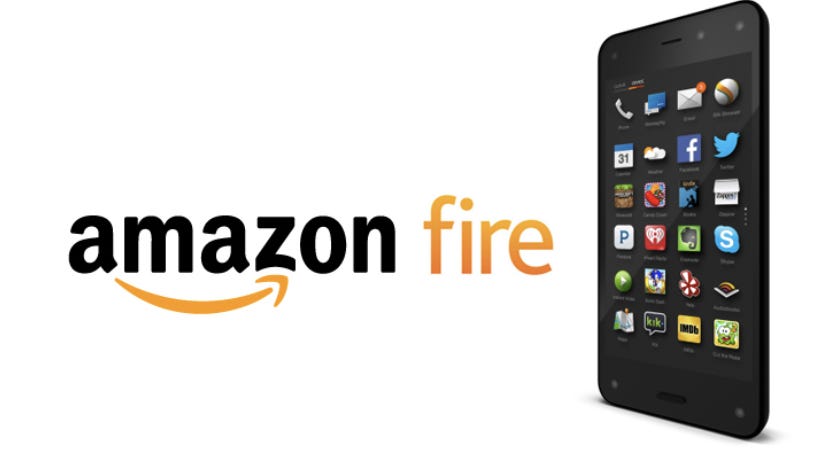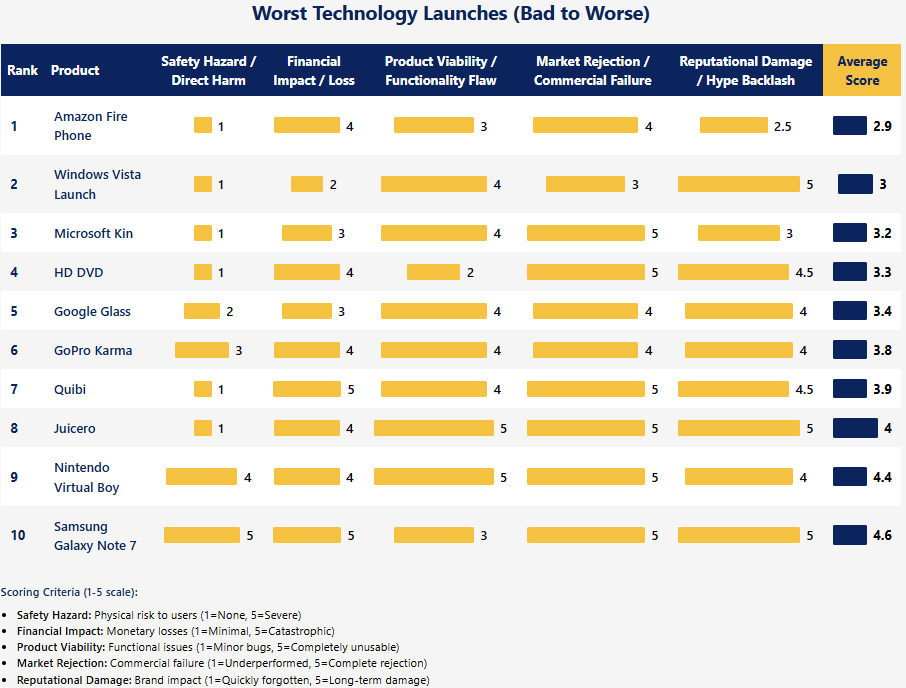10 Epic Product Failures and What You Can Learn From These Million-Dollar Mistakes
Why Understanding Past Failures Might Be Your Best Strategy for Future Success
Welcome to TJ’s Innovation Zone 💡
I'm Tomer Jakov.
In this newsletter, you'll find actionable insights, real-world case studies, and the latest emerging tech trends, designed for founders, entrepreneurs, and innovation leaders ready to turn challenges into opportunities.
Ready to lead change? Subscribe now!
The startup culture tends to celebrate success stories, drawing heavily from the playbooks of tech giants and unicorns that "made it big time." We study methodologies promoted by successful companies, read case studies of breakthrough innovations, and follow the advice of startup gurus.
All with one purpose - To hack the “success formula”
But what about the failures?
If everyone studies the same success stories, yet we still see a 90% failure rate among startups, could examining high-profile failures provide more valuable insights?
During my years working with startups and innovation leaders, I've found that understanding failure often delivers more actionable insights and value than just studying success stories.
While everyone tries to replicate successful companies, the reality is that each success story contains countless variables that are impossible to perfectly recreate.
You cannot “copy” success.
Avoiding critical mistakes on the other hand is often much easier to implement.
In my opinion, to build something lasting, you need to stay in the game long enough for your innovations to take hold...And that begins with learning how not to fail.
In this week’s newsletter I breakdown 10 of the most notorious tech product failures, the reasons behind the failures, and extract actionable lessons that can help today's founders avoid similar pitfalls.
Ranked from bad to worse, here are the 10 worst tech product launches in modern days history (with comparison table at the bottom of this post).
Let's dive...
Listen to the podcast version of this post:
#10: Amazon Fire Phone
The Promise: Amazon's Fire Phone aimed to revolutionize mobile shopping with unique features like Dynamic Perspective (creating 3D-like visuals using four front-facing cameras) and Firefly (instantly recognizing products, music, and media for quick purchasing). Amazon positioned it as the ultimate shopping companion that would seamlessly connect users to their vast marketplace.
What went wrong: Amazon created a phone optimized for shopping rather than for users' primary smartphone needs. The distinctive features didn't provide compelling value to most users. Limiting availability to AT&T significantly reduced its potential market, while the premium pricing ($199 with contract) contradicted Amazon's value proposition. The Fire Phone ultimately became one of Amazon's most visible failures, with the company taking a $170 million write-down.
Key lessons: Market dominance in one sector doesn't automatically translate to success in another, especially when facing entrenched competitors.
Prioritize solving actual user problems rather than pursuing strategic corporate objectives
When entering established markets, your differentiator must deliver substantial, not incremental, value
Exclusive distribution deals severely limit your potential audience
Test your value proposition with actual users from diverse backgrounds, not just internal stakeholders
#9 Windows Vista
The Promise: Windows Vista promised to be Microsoft's most advanced operating system yet, offering better security through User Account Control, a sleek new "Aero" interface, improved search capabilities, and enhanced multimedia features.
What Went Wrong: Vista demanded hardware requirements that most existing PCs couldn't meet, leading to slow performance. Compatibility issues meant many peripherals and software programs didn't work properly. The excessive security prompts annoyed users, while the long development cycle meant that many innovations felt dated by launch. Many organizations chose to stick with Windows XP.
Key Lesson: Functional reliability trumps new features, especially for products users depend on daily.
Ensure your product works well on existing hardware before adding resource-intensive features
Test extensively with real-world environments, not just ideal lab conditions
When replacing a stable, popular product, the bar for improvement is much higher
Listen carefully to early feedback during beta testing—users were warning about Vista's problems long before launch
#8: Microsoft Kin
The Promise: Microsoft's Kin phones were designed specifically for hyper-connected teenagers and young adults who prioritized social networking, featuring dedicated hardware buttons for sharing content and an innovative interface that aggregated social feeds.
What Went Wrong: Microsoft fundamentally misunderstood its target market, creating a device that satisfied neither smartphone users nor feature phone users. The Kin required an expensive data plan despite offering limited functionality. It lacked an app store or games—features crucial to the teenage market Microsoft was targeting. The phones were discontinued just six weeks after launch.
Key Lesson: Targeting the middle ground between market segments creates products that excel at nothing and satisfy no one.
Research actual behavior patterns of your target demographic instead of relying on stereotypes
When entering a new market, commit fully to either disrupting with innovation or meeting established user expectations
Pay attention to the complete user economic experience—the total cost of ownership matters more than device price alone
#7: HD DVD
The Promise: HD DVD promised to be the next-generation optical disc format that would replace DVDs, offering high-definition video quality, enhanced storage capacity, and backward compatibility with existing DVDs.
What Went Wrong: HD DVD failed to secure sufficient industry support compared to its rival Blu-ray. While technically similar (and in some ways superior), HD DVD lost the crucial battle for content. Sony's strategy of including a Blu-ray player in every PlayStation 3 created an installed base advantage that HD DVD couldn't overcome. After a costly format war, Toshiba officially discontinued HD DVD in February 2008.
Key Lesson: In platform wars, superior technology often loses to superior alliance-building and strategic ecosystem development.
Secure critical industry partnerships before making significant investments in new standards
Technology adoption is rarely decided purely on technical merit—distribution channels and content availability often determine winners
Build your go-to-market strategy around ecosystem advantages that competitors cannot easily replicate
When facing a format battle, analyze the competitive landscape for early indicators of which standard is gaining momentum
Know someone who’d love my content?
#6: Google Glass
The Promise: Google Glass promised to bring augmented reality into everyday life with a sleek, wearable computer featuring a head-mounted display, offering hands-free access to information, navigation, photography, and video recording.
What Went Wrong: Google misjudged the social implications of wearable cameras, creating immediate privacy backlash. The term "Glassholes" emerged to describe users who wore the device in social settings. Beyond societal rejection, the product had poor battery life, an unrefined user interface, limited applications, and a $1,500 price tag.
Key Lesson: Technologies that disrupt social norms require thoughtful introduction strategies that address both practical and cultural concerns.
Consider the "social cost" of using your product—what awkwardness or stigma might users experience?
For paradigm-shifting products, develop clear etiquette guidelines and user education materials
Early adopters need compelling advantages that outweigh the social friction of using new technology
Beta testing should include diverse social settings, not just controlled environments with tech enthusiasts
#5: GoPro Karma
The Promise: GoPro's Karma drone promised to extend the company's action camera ecosystem into the sky with an easy-to-use, portable drone featuring a detachable stabilizer that could also be used as a handheld gimbal.
What Went Wrong: GoPro ventured into an unfamiliar product category without sufficient expertise in drone engineering. The critical failure—a faulty battery latch design—revealed inadequate testing protocols. GoPro was forced to recall the Karma just 16 days after launch when units began losing power mid-flight and falling from the sky. Though relaunched later, Karma never recovered.
Key Lesson: Adjacent market expansion requires specialized expertise that can't be substituted with success in your core business.
When diversifying, acquire domain experts with proven track records in the specific field you're entering
Implement rigorous testing protocols that account for real-world usage scenarios
Consider the competitive landscape carefully—being first to market matters less than being best in market
Develop contingency plans for product failures, especially for products with inherent safety implications
#4: Quibi
The Promise: Quibi promised high-quality, premium video content optimized for mobile viewing in 10-minute episodes, with $1.75 billion in funding and leadership from Jeffrey Katzenberg and Meg Whitman.
What Went Wrong: Quibi launched a mobile-only service during a pandemic when people were largely home with access to larger screens. The company bet on expensive premium content but prohibited screenshots and sharing, eliminating viral potential. It required a subscription in a market accustomed to free short-form content. The service shut down just six months after launch.
Key Lesson: Business models must align with established user behaviors, especially for consumer media products.
Validate fundamental assumptions about how and when users will consume your content
Be alert to environmental changes that could invalidate your core premise
Study the existing ecosystem's economics—users have established expectations about pricing and value
Enable content sharing and social features from the start—they're not optional in modern media platforms
#3: Juicero
The Promise: Juicero offered a high-tech solution to healthy living with its $400 Wi-Fi connected juice press and subscription service for pre-packaged produce, promising fresh, cold-pressed juice at the touch of a button.
What Went Wrong: Juicero solved a non-existent problem with an over-engineered, overpriced solution. When Bloomberg demonstrated that hand-squeezing the packets worked just as well as the $400 machine, the company became a laughingstock and symbol of Silicon Valley excess. After burning through $120 million in venture capital, Juicero shut down less than 16 months after launch.
Key Lesson: Technology should reduce friction, not create artificial complexity that adds cost without delivering corresponding value.
Apply the "squeeze test"—if your technological solution can be easily replaced by a simpler approach, rethink your value proposition
Beware of unnecessary connectivity and "smart" features that don't meaningfully improve the user experience
In consumer products, price sensitivity increases exponentially as you move from solving pains to providing luxury conveniences
Closed ecosystems only work when they deliver benefits that truly cannot be achieved in open systems
#2: Nintendo Virtual Boy
The Promise: Nintendo's Virtual Boy promised to be the world's first portable 3D gaming console, offering immersive "virtual reality" experiences using a unique red LED display technology.
What Went Wrong: Nintendo rushed an incomplete technology to market while ignoring fundamental usability issues. The device often caused physical discomfort including headaches, dizziness, and nausea after short play sessions. Nintendo's legendary game designer Shigeru Miyamoto later admitted the product was released before the technology was ready. The Virtual Boy was discontinued within months of launch.
Key Lesson: Physical discomfort creates an insurmountable barrier to adoption, regardless of a product's technological innovation.
Physiological considerations must be resolved before addressing technological challenges
Allow sufficient time for extended usability testing that mirrors actual usage patterns
When pioneering new physical interfaces, establish clear thresholds for acceptable user experience before proceeding
Be willing to delay or cancel product launches when core experience issues cannot be resolved
#1: Samsung Galaxy Note 7
The Promise: Samsung's Galaxy Note 7 was positioned as the ultimate productivity smartphone, featuring a large display, water resistance, iris scanning technology, and a powerful battery in a sleek design.
What Went Wrong: Samsung rushed the device to market to beat Apple's iPhone 7 launch, reportedly compressing crucial safety testing timelines. The pursuit of thinner designs with higher battery capacity created pressure on battery components, leading to short circuits. The Note 7 was banned from airplanes worldwide, and Samsung ultimately recalled all 2.5 million units sold, costing the company an estimated $5.3 billion.
Key Lesson: Catastrophic safety failures can instantly erase decades of brand equity, making "move fast and break things" particularly dangerous for physical products.
Competitive pressure should never compromise safety testing protocols
When pushing technological boundaries, build in extra engineering margins and redundant safety measures
Develop comprehensive crisis management plans before launching innovative products with inherent risks
Address potential safety issues with transparency rather than minimization
Patterns of Failure
Looking across these high-profile failures, several consistent patterns emerge that entrepreneurs should heed:
Rushing to market: Samsung's Note 7 and GoPro's Karma show the dangers of compromising testing to meet arbitrary launch deadlines.
Solution looking for a problem: Juicero and Google Glass built impressive technology without addressing genuine user needs.
Ignoring user experience: Virtual Boy and Windows Vista demonstrate that technical innovations are worthless if they create frustrating experiences.
Failing to validate core assumptions: Quibi built an entire business model on unverified assumptions about user behavior.
Misreading the market landscape: HD DVD and Fire Phone show that even strong companies can misjudge competitive dynamics and user preferences.
The Way Forward
For founders navigating the challenging path of innovation, these famous failures offer valuable guardrails:
Test thoroughly: Prioritize safety, reliability and user experience above all else
Validate early: Confirm your core business assumptions before scaling
Listen deeply: Understand your target users' genuine needs, not what you think they need
Stay focused: Build expertise in your core area before expanding
Consider context: Technological capability alone doesn't ensure market success
Remember, even the most successful tech companies have experienced dramatic failures. What differentiates them is not avoiding failure entirely, but learning quickly from mistakes and adapting accordingly.
Have you encountered any product failures that taught you valuable lessons?
Share your thoughts in the comments below.
If you enjoyed this special edition, please tap the Like button below ♥️ Thank you!
To all my Jewish subscribers and friends









